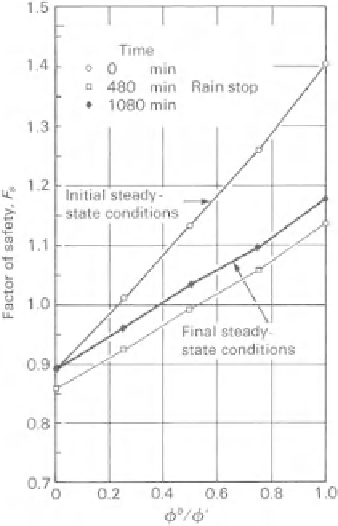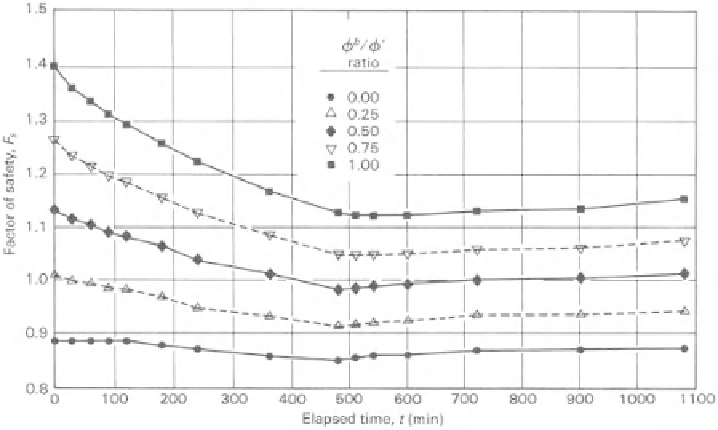Environmental Engineering Reference
In-Depth Information
is significantly increased by the contributions from negative
pore-water pressures. The above scenario illustrates how a
catastrophic failure of a steep slope might occur due to a loss
of matric suction during and following a heavy, prolonged
rainfall.
The factor of safety on a fixed slip surface starts to increase
after 480min (i.e., when the rainfall has stopped) and water
has moved deeper into the slope. The location of the critical
slip surface during and after the rainfall may be different. The
critical slip surface goes deeper as the wetting front moves
into the slope. The increase in the factor of safety appears to
occur at a slower rate after the rainfall than the decrease in the
factor of safety occurred during the rainfall period.
12.7.4 Consideration of Slip Surfaces
Near Ground Surface
Negative pore-water pressures above the water table are
often neglected when performing slope stability analyses.
There are reasons why engineers may not feel comfortable in
giving consideration to negative pore-water pressures when
performing slope stability analyses. The effect of matric suc-
tion may be omitted because (i) the theory of unsaturated
soil shear strength and water infiltration may not be well
understood, (ii) computer codes may not have implemented
the effect of unsaturated soil behavior, and (iii) there may
be a perception that negative pore-water pressures cannot be
relied upon in the long term. There are, however, a num-
ber of other related questions that the geotechnical engineer
should take into consideration when dealing with slopes that
have negative pore-water pressures.
It might be important to ask the following questions when
performing a slope stability analysis:
1. What quantitative effect will negative pore-water pres-
sures have on the slope stability study?
Figure 12.107
Factors of safety for various ratios of
φ
b
/
φ
for
various seepage conditions.
The slope stability analyses can be performed for various
elapsed times using the corresponding pore-water pressure
distributions. The changing factors of safety during the rain-
fall period are plotted in Figs. 12.107 and 12.108 for various
ratios of
φ
b
/φ
. The factors of safety continue to decrease until
the rainfall stops after 480 min (Fig. 12.108). The decrease
in the factor of safety becomes more substantial as the
φ
b
/φ
ratio increases. This can be attributed to the fact that the crit-
ical slip surface is shallow and the mobilized shear resistance
Figure 12.108
Factors of safety at various elapsed times since the beginning of rainfall.











Search WWH ::

Custom Search